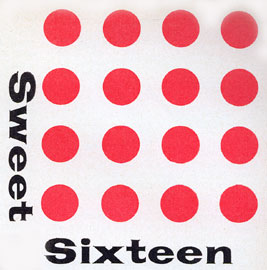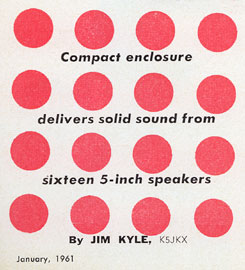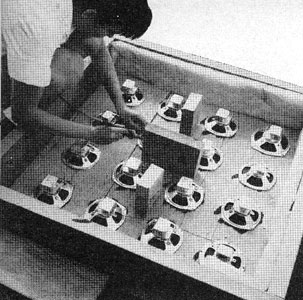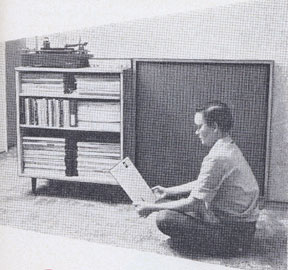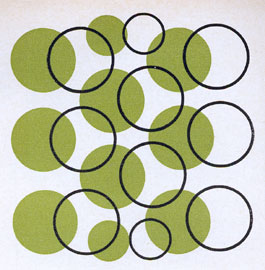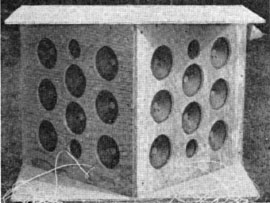My Experience with Column Systems
and how It lead to the
creation of the unique, single full range column.
These pages are copyrighted.
No portion of this site may be reproduced in whole or in part
without written permission of the author.
![]()
What Is on This Page?
The Beginning
Interest in sound, for me, may have started as early as fourth grade when I was taking violin lessons. By ninth grade, I was a devoted listener to all kinds of classical music. In the early 1950's, good sound was hard to find and nothing seemed to accurately reproduce a violin. There were all kinds of speakers available and they were all lacking in one quality or another. There had to be something better. That was probably when I became a dedicated loudspeaker enthusiast.
While in high school, I was able save enough money to purchase my first serious hi-fi equipment: a Heathkit Williamson amplifier, University Diffusicone speaker, VM record changer and Cabinart baffle—and so it began. I built many different amplifiers and speaker systems after that in my search for better sound.
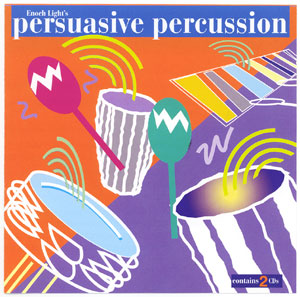 My first exposure to
stereo reproduction was in the early 1950’s to Emory Cook’s binaural recordings
and the AM-FM stereo broadcasts from WQXR in New York City that I received on a
National Criterion Binaural tuner. I soon had a Viking FF-75 stereo tape deck
and was making recordings of a Wurlitzer pipe organ at the Lowes Theater in New
Rochelle, NY. At that time I was using Telefunken dynamic microphones. This was
later followed with a Magnecord 728-44 professional recorder that I used to
record a few concerts plus thunderstorms and even diesel trains at Harmon, NY.
My first exposure to
stereo reproduction was in the early 1950’s to Emory Cook’s binaural recordings
and the AM-FM stereo broadcasts from WQXR in New York City that I received on a
National Criterion Binaural tuner. I soon had a Viking FF-75 stereo tape deck
and was making recordings of a Wurlitzer pipe organ at the Lowes Theater in New
Rochelle, NY. At that time I was using Telefunken dynamic microphones. This was
later followed with a Magnecord 728-44 professional recorder that I used to
record a few concerts plus thunderstorms and even diesel trains at Harmon, NY.
In my pursuit of stereo sound over the years, I became what might be considered, obsessed with making loudspeakers systems that could more accurately reproduce all of the stereo information contained in recordings. In the early days of stereo, I remember the very popular 1960 recordings of Enoch Light's "Persuasive Percussion." Some instruments came from the left speaker and others from the right speaker. Although this might be referred to as a stereo recording and certainly made use of left and right images, it didn't seem to fit my quest for the best stereo sound. I think it did serve as an effective introduction to stereo sound at that time where listeners heard the novelty of a different instrument coming from each speaker.
After graduating in 1959 from Rensselaer Polytechnic Institute in Troy, NY with a degree in Electrical Engineering, I gained experience while working as an engineer in the Audio Products Section of the Sonotone Corporation in Elmsford, NY--a well known manufacturer of hearing aids and other audio products. I spent 8 years there designing a new line of loudspeakers and microphones. I also wrote my first two magazine articles about a stereo volume expander-compressor and sealed speaker system design.
![]()
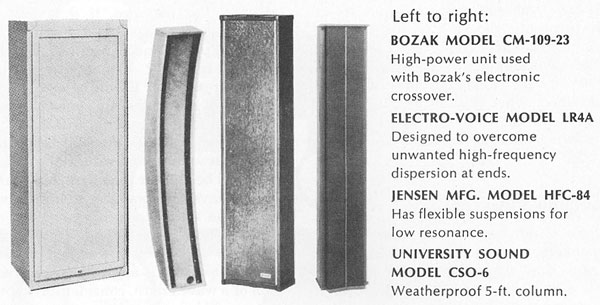
These systems were reported by Victor Brociner in Audio magazine, August 1969. The use of column speakers dates way back at least to the late 1950’s and perhaps even earlier. They were used as public address systems because they could direct the sound over a wide horizontal angle and a very narrow vertical angle instead of dispersing it where sound was not wanted or needed. This reduced the amount of reverberant sound and increased intelligibility in large rooms and auditoriums. It also reduced the possibility of acoustic feedback to the microphone. The response did not cover the entire frequency range but was more than adequate for voice range and even music of moderate quality. The sound was much superior to PA horn systems.
Besides having all the drivers radiate the same frequency range, there can be many other variations for driver sizes, column curvature and electrical control. In response tapering, for instance, the whole frequency range can be radiated by the center speakers and the highs electrically attenuated by increasing amounts from driver to driver as they progress away from the center driver. This will broaden the vertical dispersion. Most of my work has been in straight columns with the drivers all covering the same frequency range.
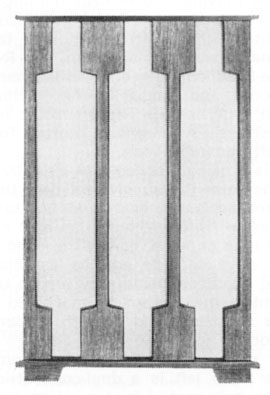 My interest in
column speakers for the home began about 1961 while working at Sonotone. We
needed a new set of speakers for the listening room to do listening evaluation
of phonograph cartridges. I had recently auditioned a pair of Bozak B-4000
systems, also known as Symphony 1. Each system had 2-12” woofers an 8”
mid-range and a column of eight tweeters that started down from the top. The
dimensions were 44” high, 27-13/16” wide and 16” deep. The price of this Modern
design in oiled walnut was $495. An alternate style featuring a double-arch
design sold for $510.
My interest in
column speakers for the home began about 1961 while working at Sonotone. We
needed a new set of speakers for the listening room to do listening evaluation
of phonograph cartridges. I had recently auditioned a pair of Bozak B-4000
systems, also known as Symphony 1. Each system had 2-12” woofers an 8”
mid-range and a column of eight tweeters that started down from the top. The
dimensions were 44” high, 27-13/16” wide and 16” deep. The price of this Modern
design in oiled walnut was $495. An alternate style featuring a double-arch
design sold for $510.
The B-4000 was very favorably reviewed in the Decmber 1965 issue of High Fidelity magazine. The tweeter arrangement was referred to as a “line radiator and the array of drivers is fed into a narrow opening, or slot, which—because of its inverted taper, helps spread the highs and load them to the room with a broad and smooth dispersion pattern.”
The systems were made in mirror pairs with the tweeter columns at the inside. I was taken by the imaging ability of the column but had to be seated so that I was within the height of the enclosure and fairly close to the systems. Unfortunately, management decided not to purchase them and, of course, they were too expensive for me to buy at that time.
![]()

During my employment at Sonotone, from 1959 t0 1967, I enjoyed going on Audio Engineering Society tours. One of them was to the Bozak factory and meeting Rudy Bozak. I was very surprised to see how the cones were made—a handful of “glop” was dropped into a bucket of water with a perforated conical form at the bottom. After the “glop” settled the cone was pulled out with a wire attached to the center of the form and behold, there was a beautiful Bozak cone. It was smooth in the front except for the tiny drain holes but was very rough on the back. This probably helped reduce cone breakup when in operation. The ingredients of the “glop” were proprietary but apparently there was animal hair, tar and who knows what else, but it worked well. I can’t imagine how much time it took to arrive at the best formula.
Rudy did not adhere to the acoustic suspension principle. In fact, in his 1970/71 “The Bozak Dealer” newsletter he denounced air suspension combined with equalization to create big bass in a small box. Now, I just wonder if he was referring to the newly introduced McIntosh ML-1C and equalizer.
The text is as follows:
“We’ve been hearing a lot again about ‘New Technology’ in loudspeaker design. Nobody seems to know exactly what it means this time, but we gather that it refers to a mixture of so-called ‘Air-Suspension’ and ‘Equalization’ to create big bass in a small box. Neither of these techniques is really new and both have a questionable relationship to genuine High Fidelity. In evaluating the results of this ‘new’ technology you must keep in mind some basic characteristics of the speaker that control the quality of the sound. One of these is Resonance. To achieve low bass, the speaker must have a low resonant frequency.
Air Suspension systems (more accurately ‘pneumatic restoration’) employ a small box to present a very stiff rear load to the cone; to compensate for this; the designers increase the weight of the cone to achieve the desired low Resonance Frequency. With music you have percussive and other complex wave forms. These require excellent transient response in the speaker. A heavy moving system just isn’t agile enough to follow transients. Its slow attack and delayed release (‘hang-on’) slur these evanescent components of music, as can be heard by experienced ears and demonstrated by oscillograms.
Then there’s the matter of Bass Power. As is common knowledge, and as we have consistently emphasized, bass power varies with the volume velocity of air moved, and the lower the frequency, the more air moved, and the lower the frequency, the more air you have to move.
With a small box you can’t displace enough air to develop good power in the lower frequencies. As an antidote for inadequate cone-size and cone-travel we are offered Equalization—which is, in the last analysis, not much different from the ‘bass boost’ that we have always had with tone controls. Old timers know that boosting the bass under these conditions increases distortion—and we have established by test that the increase is not just a few percent but can be as much as 1000%!. (For collateral reading see Bozak Dealer for May 1970, March 1968 and March 1967.)
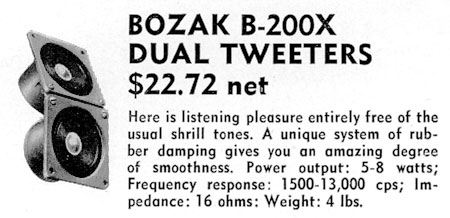 You can’t defy the laws of
physics and produce an illusion—but that’s a price we won’t pay in a box of any
size.”
You can’t defy the laws of
physics and produce an illusion—but that’s a price we won’t pay in a box of any
size.”
Never-the-less, the higher efficiency ML-1C woofer, with its 3/4 inch excursion woofer, outperformed his low efficiency 1/4 inch excursion woofer for both transients and volume velocity. The ML-1C produced only 3% distortion at 25 Hz with 100 watts input. That was more bass power than his woofer could handle.
Here's an ad for Bozak tweeters found in the April 1953 issue of Audio Engineering. The tweeters are 3-1/4" square. These are probably an earlier version of the tweeters later used in the B-4000. Later, I was able to test some of the early tweeters. They were very smooth out to 10 kHz but then cut off sharply.
A pair of tweeters was often mounted horizontally across the center of the 12” woofer. It was sort of like a coaxial speaker and offered the advantage of taking up less space on the front panel of the cabinet.
![]()
This page was supposed to be about my experience with column speakers but the Sweet Sixteen system deserves to be recognized and is indirectly related to column design. It appeared as an article by Jim Kyle in Popular Electronics, January 1961. The story described construction of a speaker system using sixteen 5-inch drivers arranged in series-parallel in a single enclosure. It was a new idea back then and was awarded The Best Hi-Fi Article of the year in the November 1961 issue of Popular Electronics. For months the author was deluged with mail, while manufacturers happily sold over 12,000 speakers for use in the Sweet Sixteens.
|
|
|
|
|
|
You might have guessed that I made one of these back then and you would be right. As with other readers, I was intrigued by the claims that with 16 drivers, response was flat to 20 Hz and that the excellent transient response in the mid-range was the major reason for the system’s sweet sound. I was able to get sixteen drivers at a good price from Becker Electronics in East Durham, NY, our driver supplier for Sonotone at that time. I was not sure that I was able to hear those claims at that time or perhaps there were additional factors to be considered in how the system actually performed. No measurements were provided in the article.
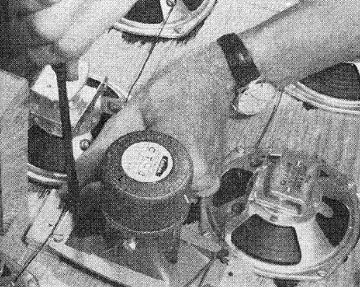
I did find that the system lacked high frequencies. This was not unexpected because the driver response was limited at the higher frequencies. In April 1961, Jim had a second article published in Popular Electronics. This was titled “Sweeter with a Tweeter.” He claimed that the original system would extend from below audibility to just less than 10 kHz and that a tweeter would extend the range to beyond 16 kHz. The tweeter was added between the top and second row of drivers at the center of the system. A tweeter level control was also used for the readers to set to their preference for highs. The picture shows a horn tweeter being installed.
|
|
|
Following this success, Jim wrote a third article titled “Stereo Sixteen Plus Four.” This was another unusual design using eight 5-inch drivers and two tweeters per channel but having the two channels arranged in a single angled cabinet. The system was designed to face into the wall and, in fact, was recommended to be placed against the wall. All of the sound was then reflected from the wall. This arrangement looks similar to a Bose 901 but, of course, the Stereo Sixteen contained both channels.
It appears that in reply to the Sweet Sixteen article, James Novak at Jensen wrote a seven-page article titled “Performance of Series-Parallel Speaker Arrays” that was published in Audio Magazine in September 1961. It contained many charts and response curves and explained that there were expected losses at both high and low frequencies in the Sweet Sixteen arrangement due to driver spacing, driver directionality, etc., so it looked like there was more to the story than was first explained. However, many of the effects mentioned in the Novak article are also applicable to column design.
![]()

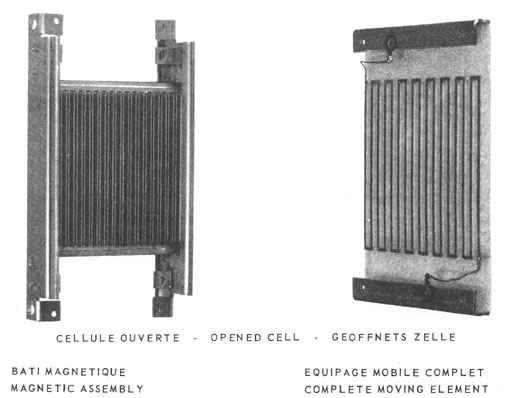
I also learned of the Orthophase flat panel speaker cell made in France. They could be stacked in a column of many cells. In July, 1961, I inquired to Mr. Georges Gogny in Paris, France about the specifications and cost for these drivers. These speaker cells were 4” X 8” and could be arranged in a column that would cover the frequency range from 1000 to 25,000 Hz. However, with the addition of more cells, the lower frequencies could be extended. Each cell had a diaphragm made of a thin, rigid, flat section of expanded, very light weight plastic foam. The magnet structure, in the left picture, was made up of ceramic magnets along raised steel strips so the conductive tape, in the right picture, lay in the strong magnetic field. The diaphragm was able to move uniformly back and forth. The impedance of each cell was 0.35 ohms. At that time, the cost for each cell was 212 N.F. or $42.50 each a plus the cost of importing. Unfortunately, a set of 16 cells was beyond my budget.
The Orthophase family of systems was reviewed in the December 1964 issue of High Fidelity magazine. The smallest system had a single cell and a dynamic woofer. Other systems had more cells. The systems did not have the cells arranged in a column but were side by side. The OR-12 had 12 cells and no woofer. The cells were arranged in a rectangle and the cabinet height was only 27 inches. That sold for $785. Because the cell impedance was so low, a matching transformer was necessary to present an 8-ohm impedance for the amplifier. The exception was the OR-12 that had no transformer. The cabinets were open back, similar to an electrostatic speaker system. The systems were only moderately efficient.
![]()

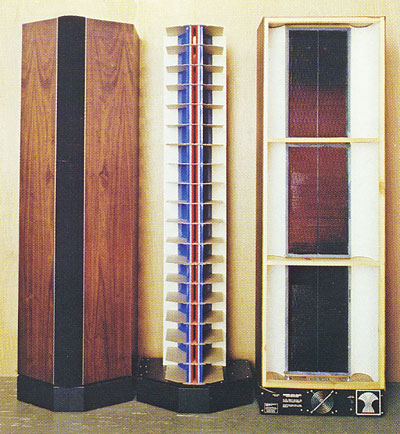 The opportunity to further
investigate columns came with the need for higher power handling at high
frequencies for McIntosh speaker systems. The time was about 1976, when I read
about the Cylindrical Sound system of Harold Beveridge. This was an
electrostatic column speaker, patent number 3,668,335 issued on June 6, 1972.
This may have been the first single column that covered almost the entire
frequency range.
The opportunity to further
investigate columns came with the need for higher power handling at high
frequencies for McIntosh speaker systems. The time was about 1976, when I read
about the Cylindrical Sound system of Harold Beveridge. This was an
electrostatic column speaker, patent number 3,668,335 issued on June 6, 1972.
This may have been the first single column that covered almost the entire
frequency range.
In the Beveridge literature, it says “This 6-foot high device consolidated the entire frequency range into a vertical line source, and uniformly disperses it over a horizontal pattern, 180 degrees wide. The beaming characteristics of the high frequencies are ingeniously translated into the same dispersive pattern as the low frequencies, creating a perfectly balanced cylindrical sound wave front. The end result is flawless stereo fidelity in the home, and that, says Harold Beveridge with a grin, is what the last quarter of a century was all about as far as he was concerned.”
An integral amplifier was located in the base and did require a cooling fan. Electrostatic speakers need high voltages to drive the diaphragm. The amplifier could deliver peak outputs greater than 1500 volt amperes into the speaker’s capacitive load of 5000 pf. Response was claimed to be plus or minus 2 dB from 40 to 15kHz and over a wide angle of 180 degrees. The lowest useable output was 35 Hz. The system was 6-1/2 feet tall, 2 feet wide and depth was 16 inches at the center with 10 inches at the sides. The price was $4000.00. It was sold by Harold Beveridge Inc., 422 North Milpas Street, Santa Barbara, CA 93103. I was never able to hear a Beveridge system but had no doubts that it would have produced excellent stereo.
![]()
Infinity IRS
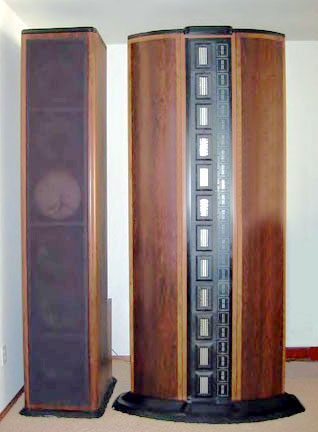 The Infinity IRS system appeared about
1980. It had a column of six 12-inch woofers, twelve flat ribbon mid-range
drivers and thirty six flat ribbon tweeters. Twelve of the tweeters were facing
to the rear, which automatically meant that the system could not be placed
against the wall but must be located out in the room as it is shown in the
picture.
The Infinity IRS system appeared about
1980. It had a column of six 12-inch woofers, twelve flat ribbon mid-range
drivers and thirty six flat ribbon tweeters. Twelve of the tweeters were facing
to the rear, which automatically meant that the system could not be placed
against the wall but must be located out in the room as it is shown in the
picture.
The woofers were contained in a separate enclosure at the left. The system weighed 1200 pounds. It was was 90 inches tall and had a rosewood veneer finish.
![]()

XRT20 Long Column
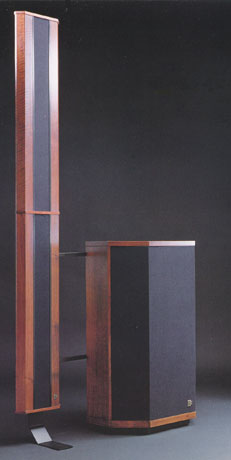 Being hired by McIntosh to
design speakers is the beginning of a dream come true. My first speaker design
is for the ML-1C system. I designed an equalizer that was used in conjunction
with an overdamped 12” woofer to produce flat response down to 20 Hz. No other
speaker system could do this and I was awarded my first patent.
Being hired by McIntosh to
design speakers is the beginning of a dream come true. My first speaker design
is for the ML-1C system. I designed an equalizer that was used in conjunction
with an overdamped 12” woofer to produce flat response down to 20 Hz. No other
speaker system could do this and I was awarded my first patent.
In the late 70’s, after designing many different systems, an improvement was needed for more power handling at high frequencies. This was brought about by the higher power amplifiers that engineering kept coming up with and also the spectrum of rock music that contained more energy at the higher frequencies. Here was an opportunity to get into column systems.
At the same time, I am able to show management that the investment in our new large anechoic chamber is justified for further advancement in speaker research and design. It enables Carl and I to measure the relevant parameters that go into the design of long, and later, short columns. It also provides a way to get a handle on what had been the elusive quality of reproducing depth and spaciousness.
I thought that a good solution for the immediate problem might be a column of 1" dome tweeters. It might be able to reveal images like what I had heard with the Bozak B-4000 and at the same time solve the problem of high power handling at high frequencies. The column for the first prototype was made in 1979 with twenty five Philips 1" soft dome tweeters that have a circular plastic mounting plate. The tops and bottoms of the plates are cut off to allow closer spacing of the domes. Later, we have custom rectangular plates made for this purpose. The tweeters are mounted on a board 1-1/2" thick and 10-1/2” wide. It is placed against the wall and runs from floor to ceiling in the listening room. The long columns avoids the requirement to be seated for best listening like with the B-4000. They also reduce floor and ceiling reflections. All the tweeters have very close response tolerances and are essentially identical. They each cover the frequency range from 1500 Hz to 20,000 Hz and provide outstanding imaging. They can be played very loud and we design a suitable bass system to go with them--and so, the XRT20 was born, shown at the left. It is the first McIntosh column. It works so well, I receive two patents for the design. Although the tweeter column is designed to be mounted on a wall, a stand is also provided for those installations where wall mounting is not possible. After the XRT20 begins production and my patents are issued, I receive several notices from a patent research company concerning references to my arrangement of closely spaced drivers in a long column. This includes Martin-Logan that made electrostatic systems. The XRT22 is a later version and is similar in design.
A preconceived notion about a long column is that it produces comb filtering and tweeters interfere with each other causing sharp narrow dips in response. Although this can be shown by producing sine wave response curves, it fails to explain why it is not heard. Our hearing process compensates for this by the Precedence or Haas effect. After hearing an initial signal, the brain will suppress any later signal, such as an echo, for a time up to about 30 or 40 milliseconds. This inhibition is called time or temporal masking. In effect, you do not hear the sound from the higher or lower drivers that would otherwise interfere with locating the nearest source of the sound. It is thought to have evolved as a survival response. The behavior explains why the highs in long columns like the McIntosh XRT20 and XRT22 seem to always come from the area opposite to your listening height. For further information see my XRT20 and XRT22 pages.
The XRT18 Short Column
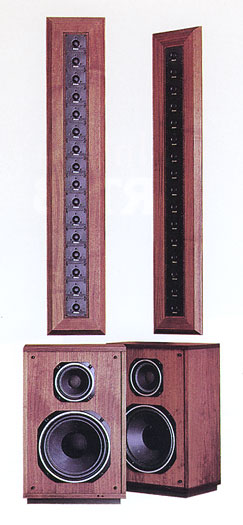 The XRT18 is a short
column system that we design later. The cost for this system is significantly
reduced and floor space requirements are also reduced. However, satisfactory
listening height is only in the area directly opposite the column and not
beyond. The center of the column is arbitrarily designed to be used half way
between the average listening height for sitting and standing. As I recall this
is about 54 inches. Although the column could be curved at one or both ends or
bowed out in the center, this makes for more awkward placement in the home. By
keeping the column straight, it can still be hung on a wall or an optional
stand.
The XRT18 is a short
column system that we design later. The cost for this system is significantly
reduced and floor space requirements are also reduced. However, satisfactory
listening height is only in the area directly opposite the column and not
beyond. The center of the column is arbitrarily designed to be used half way
between the average listening height for sitting and standing. As I recall this
is about 54 inches. Although the column could be curved at one or both ends or
bowed out in the center, this makes for more awkward placement in the home. By
keeping the column straight, it can still be hung on a wall or an optional
stand.
To improve the vertical directionality at the ends of the column, power tapering is used where the power is the highest for the center tweeters. It is then reduced in steps of two tweeters towards each end of the column. However, attenuation is only at the lower portion of the tweeter frequency range. The column then has the highest output at the center. This makes the column a little more like a point source at the center and is a little less like the behavior of a long column. There is also a loss of efficiency, resulting in more power needed for the same listening level.
To make the crossover adjustments for the response, a computer program is developed to incorporate variables of tweeter spacing, attenuation versus distance, directionality, number of tweeters, etc. It produces a formidable number of solutions. Even after streamlining the program to leave out solutions that would be of no value, it requires the use of a Digital Equipment super computer and 91 hours of running time. That was a big deal in 1983 and 1984.
Our computer generated crossover design is a unique solution to this problem by tapering the response from the center to the ends. This affects only the lower portion of the tweeter range and is not the same as the conventional power tapering for the whole frequency range of the system. Four separate crossovers are used for the tweeter groups. For further information see my XRT18 page.
The XR19 Curved Column
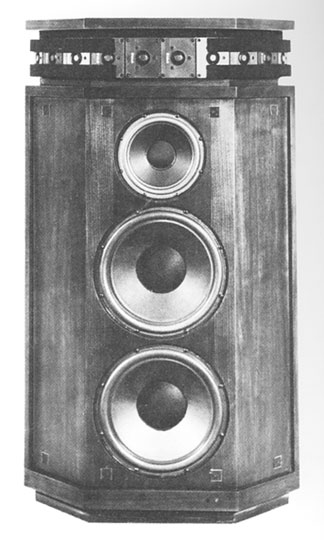
This system is designed to provide some of the benefits of power handling, imaging and spaciousness that the XRT20/22 systems have. It also eliminates the requirement for a separate tweeter column. It contains a column of twelve tweeters but it is located horizontally. If the line were straight, this short column would be very directional horizontally and listeners seated in the center position between the speakers for stereo would hear very few highs. They would only be heard directly in front of one system and not off to the sides.
However, by rearranging the tweeters into a semi-ellipse, output can be maintained to the sides. Vertical response is inherently very good. Felt strips are placed above and below the tweeters to prevent edge reflections from above and below. Because the tweeters are located far above the floor, reflections somewhat reduced.
The curved array is an alternate solution to providing good dispersion with a short horizontal column. This could have been done vertically but was not as practical for the home. The horizontal column also works very nicely at the top of an XRT20 cabinet. Although only 12 tweeters are used in the XR19, the power handling is still comparatively high at 150 watts of program material from 1.5kHz to 20kHz.
The system is shown with the top and bottom grille covers removed. The imaging and spaciousness of this system remains very good.
For further information see my XR19 page.
The XR290 Triple Column
 The XRT20/22 tweeter
column provides excellent imaging for the high frequencies but it also required
a separate mid and bass cabinet. The combination takes up a lot of floor space.
By 1990, management was looking for a column system in a single cabinet and
this led to a new design.
The XRT20/22 tweeter
column provides excellent imaging for the high frequencies but it also required
a separate mid and bass cabinet. The combination takes up a lot of floor space.
By 1990, management was looking for a column system in a single cabinet and
this led to a new design.
Encouraged by the listening quality of my previous designs that incorporated only a high frequency column portion, there was a hint of more benefits that could be gained with a column. In retrospect, that if a column of tweeters made improved listening quality, then several columns, one for each frequency range, could further improve the sound as well s the power handling of the entire system. This was my chance to create a triple column system. Our first prototype was seven feet tall and 25" wide.
Originally, the
first prototype contains a column of twenty-four 1" soft dome tweeters and
a column of four 12" woofers. An 8" mid-range was located between the
bottom and top two woofers. We soon found that sound bouncing off the floor
from the mid-range interfered with the direct radiation. A second mid was added
in the hope of canceling radiation to the floor, but this 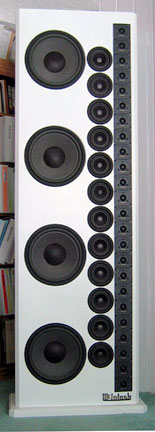 arrangement had a very restricted
listening area.
arrangement had a very restricted
listening area.
Finally, it became obvious the only answer was to add that third column of twelve 5" mid-ranges which avoided the floor bounce problem altogether. We end up with a triple column system, which was an expansion of the original tweeter column concept. The accuracy of this system is even better and is fascinating to listen to. It becomes the XR290, shown at the right. There is a total of 40 drivers but despite the number, it is only a 3-way system. It has the new McIntosh LD/HP woofers that havecopper shorting rings above and below the pole piece and reduce distortion by a factor of 10.
I make the white system at the left after I left McIntosh using the original prototype parts and dimensions. Like the original prototype cabinet, the front is not angled back and the tweeters were not spaced away from the mids. The cabinet is one piece as I never planned to ship this anywhere. The cabinets took a long time to make. I used fiberglass as the acoustic material instead of the fire retardant cotton that was used in production systems. I never did make grilles for these two systems.
Although I thought this system would be my last and final system at home, there was still some unfinished work that I never did complete while at McIntosh and early experiments at the lab were the beginning of what I really wanted.

 In 1985, prior to the design of the XR290,
Carl and I experimented with combining the mids and highs into a single driver
column that could extended response down to 150 Hz or so and provide even
better imaging. However, the best of the so-called wide range drivers that we
tested just didn't have wide enough dispersion or go high enough in frequency.
More importantly, depth and spaciousness was minimal. The front view is at the
left and the side view is at the right.
In 1985, prior to the design of the XR290,
Carl and I experimented with combining the mids and highs into a single driver
column that could extended response down to 150 Hz or so and provide even
better imaging. However, the best of the so-called wide range drivers that we
tested just didn't have wide enough dispersion or go high enough in frequency.
More importantly, depth and spaciousness was minimal. The front view is at the
left and the side view is at the right.
Later, a tweeter was added in the middle of the column to extend the range. Unfortunately, it did not handle any power and it broke the continuity of the column right at the seated listening height.
Along with four 10-inch woofers, we were essentially back to a 3-way system and with no high frequency power handling plus a discontinuous mid-range. It reminds me of the story told by Larry, The Cable Guy, about a man whose horse had broken a leg so he shot the horse because that is what you are supposed to do when this happens. Now he has a horse with a broken leg and a bullet wound.
Now that I think of it, this system looks a lot like the Beveridge system. Unfortunately, further research was abandoned because of immediate needs for other designs.
![]()
A Unique Wide-Range Single Column
Designed by Roger Russell
I left McIntosh in late 1992 and never created the system that I really wanted. It was curiosity that kept me thinking all this time about how it would sound. The success of my first column patent and the enthusiasm generated by customers for my earlier McIntosh designs using tweeter columns was encouraging. That led to the XR290 triple column and that was a step in the right direction. For me, this logically led to combining the whole frequency range into a single column of wide-range drivers and does away with those troublesome crossover networks. I could also use the experience gained with my second patent using equalization for low frequency compensation.
In retrospect, a single diaphragm microphone is used to make recordings, thus preserving the coherence or transients of the events. Further, headphones contain single wide-range drivers . No separate drivers or crossovers are used. I found a listening quality even in inexpensive headphones that is not heard in speakers. There is a coherence and clarity that makes listening important. It is the transients that are preserved.
One of the problems of independent research and design is expense. Some drivers, although promising in response, were very expensive and a long column of them could cost well over $1000. That was a big financial risk to take to either confirm or disprove that my idea would work the way I had envisioned it. Thanks go to an email friend in Atlanta, who had seen my work on columns in October 2000. He had asked if I could recommend some drivers he had found. I tested a couple of them for him and for the 69 cent price, these 4-inch wide-range drivers worked well enough to test my theory. They were originally intended for use in television sets. It was a way to begin. I started construction in 2004.
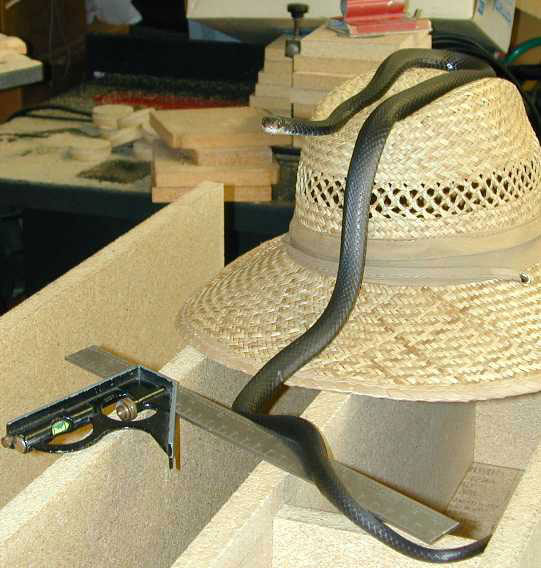
During construction of the cabinets, I was visited by my friend the Black Racer who was supposed to be out in the yard patrolling for bugs and lizards—but then, what else could I expect when living in Florida?
Unlike the first system that Carl and I made in the lab, I made this enclosure very narrow. I had been resigned to adding a woofer to each column but that was the easy way out to extend the low end, I found that my patented method of equalization was a better approach to bring up the bass and also compensate for the inherent loss in the highs. Although this approach seems quite unreasonable, particularly for very small drivers, the science behind this is why it works--and very well I might add. The effective cone area is equal to two 12-inch woofers and there is a 10 dB of acoustic gain as well. These particular drivers, when combined with equalization, provide response from 25 Hz to about 15 kHz. Power handling is very high and imaging is outstanding. It also fulfills my goal of having only a single column of drivers to cover the whole frequency range. The cabinet size is 87-1/2” high, 6-1/2” wide and 9-1/4” deep without the base. I wrote an article about this first prototype system titled “A Unique Stereo Column System” that was published in audioXpress magazine in November 2005. The design includes two of my previous patents: speaker equalization and drivers arranged in a long column. Below is a picture of the system in my first article.
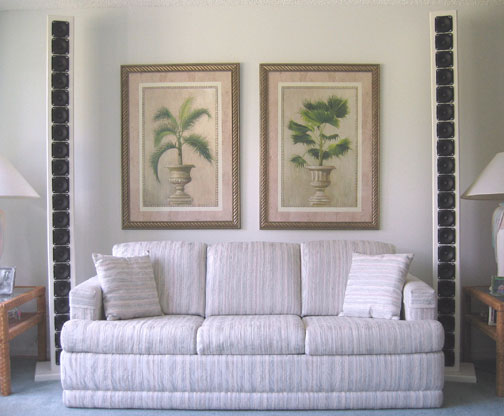
What is a line radiator anyway? It is not several lines consisting of woofers, mids and tweeters or any multiple lines or a line and a woofer. It is one line and all of the drivers radiate the entire frequency range with no other lines or add-ons. This is my invention and it works unbelievably well. The big surprise for those who have never heard such an unusual system is the tremendous bass output that is not expected from such little drivers. Another first listening impression is that the transients are accurately preserved and the music dramatically comes alive but these are only the beginning of the surprises that the system brings.
The IDS-25 Stereo Loudspeaker System
After establishing that this idea could indeed work, I proceed to make an updated system that is greatly improved and I use twenty five high-technology 3-1/2” drivers that provide better highs and lows, wider dispersion, smoother response and lower distortion. They are a lot more expensive and it is still a big risk but the results of my first system are too promising to ignore. I add a grille and some other features. With equalization, it goes from 20 Hz to 18,000 Hz and beyond. It then has the listening qualities I have sought after for all of these years—accurate imaging, depth and spaciousness. I also discover a bonus feature of outstanding coherence producing dramatic transients. My search for the right components and more accurate sound had been rewarded and I had achieved what might be the ultimate column system, that is, unless I came up with something even better, if that is possible. I wrote a second article about this revised design titled “Upgrading a Unique Stereo Column System” for audioXpress published in the July 2006 issue. It described my latest improvements.
A good wide-range driver is hard to find and I finally located one that has the qualities I was looking for.
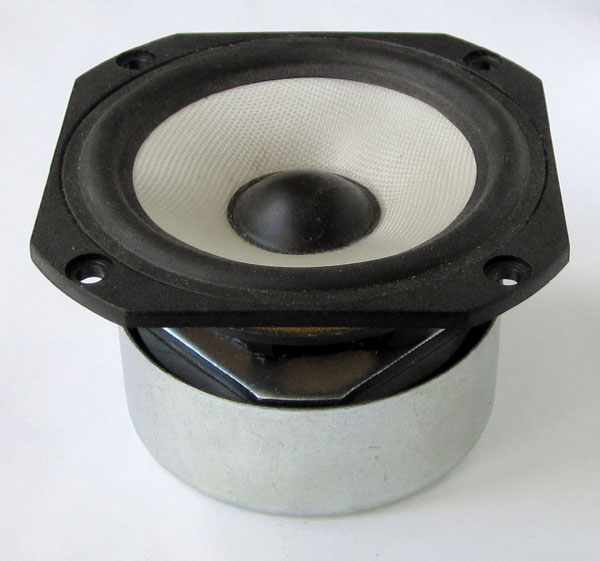
Although this is called a 3-1/2 inch driver, the actual radiating diameter is only 2-1/2 inches. The basket is squared off on four sides allowing closer placement of the drivers. The metal cover in the rear contains the shielded magnet structure and extra reversed magnet. This eliminates stray magnetic fields. Shielding may not be as important today but could interfere with older TV sets having picture tubes.
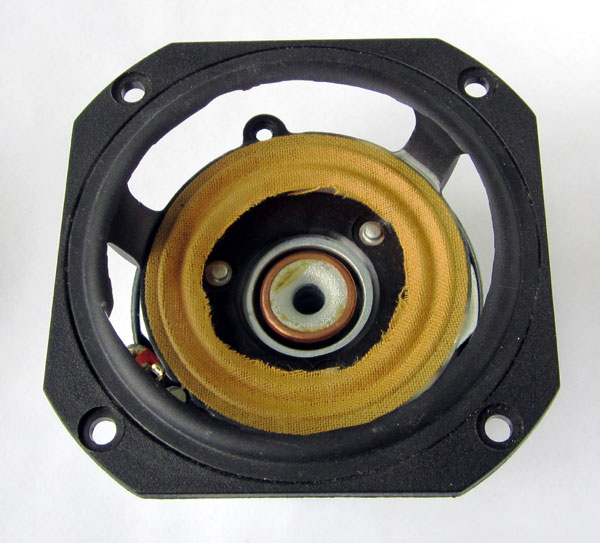
I cut out the surround and spider of one to show the internal construction. One of the features I was looking for is the use of a copper shorting cylinder in the magnetic gap. This reduces distortion by as much as a factor of 10. The end of the cylinder can be seen in the center of the picture. The outside edge of the spider centering material is flat as opposed to a cup shape found in some woofers. A flat spider provides equal compliance in both directions.
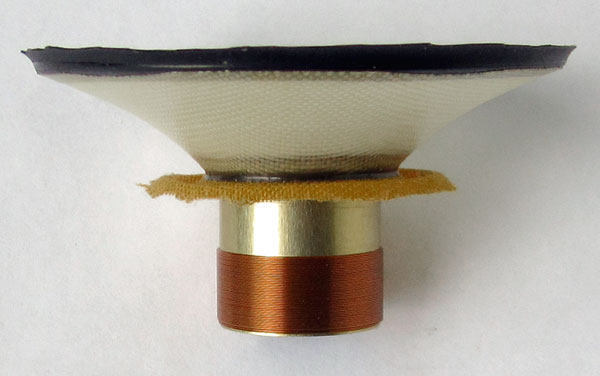
Another feature is the long voice coil winding height. This provides a large amount of overhang resulting in a long linear excursion capability. The cone material is made of woven fiberglass. Past experience with cone and dome materials has shown that distortion is significantly lower with woven material that dissipates energy along the surface compared to rigid plastic or metal construction. It is also not sensitive to temperature and humidity changes like paper. The surround material is thin rubber and is not subject to disintegration like polyurethane foam. The total weight of the moving parts is only 2.5 grams, the same weight as a dime. That calculates out to be 0.088 ounces.
The second version was made several years ago and since then I have further refined the enclosure and equalizer. It has now become a marketable system with a professionally made custom equalizer and high quality enclosure and grille. The system is now known as the IDS-25. It was a big hit at the Rocky Mountain Audio Fest and received excellent reviews from several prestigious organizations. The system is somewhat radical in design and its excellent performance has dispelled doubts about the behavior of this sort of system that are not well understood. Needless to say, I have applied the same principles that the system must both measure good and sound good in order to qualify as an acceptable loudspeaker. This is now the most accurate speaker I have designed. It has revitalized my appreciation of classical music and the incredible sound has brought tears to my eyes more than I would like to say. The IDS-25 has replaced my McIntosh XR290 triple column system.
![]()
The difficulty is not in coming up
with new ideas, but to undo the old ones.
 Several years have passed since
my first listening experience to my single wide-range column system. I never
cease to be amazed at the captivating sound, even in the first few seconds of
listening. This system outperforms all of
my earlier designs, whether it is a column or convention multi-way type. Here
is truly a system that can deliver better sound reproduction and at levels
equal to that which you would encounter at a concert hall. The sound quality becomes obvious seemingly regardless of
the kind of program material that is played through them. Still, in the back of
my mind, is the discrepancy between all of my years of conditioning to large
woofers being needed for deep bass and then seeing nothing but small drivers.
But even then, how much bass can these little drivers put out despite having a
large combined effective area? Then, I keep reminding myself that there is also
the acoustic gain of all of these little drivers working together in a column,
10dB of gain in all, making the system appear to be twice as loud and that is the
equivalent of 10 times the power from an amplifier. Only 1 watt is needed to
give performance equal to 10 watts and with no increase in distortion. Well,
it’s one of those things where hearing is believing but it is nice to know that
there is a scientific explanation and this is not just an illusion. I really
think the solution is to place the speakers behind a curtain so the visual
distraction is eliminated. I could even suggest placing a couple of subwoofers
next to the columns but not connecting them. This could give some eye relief.
Several years have passed since
my first listening experience to my single wide-range column system. I never
cease to be amazed at the captivating sound, even in the first few seconds of
listening. This system outperforms all of
my earlier designs, whether it is a column or convention multi-way type. Here
is truly a system that can deliver better sound reproduction and at levels
equal to that which you would encounter at a concert hall. The sound quality becomes obvious seemingly regardless of
the kind of program material that is played through them. Still, in the back of
my mind, is the discrepancy between all of my years of conditioning to large
woofers being needed for deep bass and then seeing nothing but small drivers.
But even then, how much bass can these little drivers put out despite having a
large combined effective area? Then, I keep reminding myself that there is also
the acoustic gain of all of these little drivers working together in a column,
10dB of gain in all, making the system appear to be twice as loud and that is the
equivalent of 10 times the power from an amplifier. Only 1 watt is needed to
give performance equal to 10 watts and with no increase in distortion. Well,
it’s one of those things where hearing is believing but it is nice to know that
there is a scientific explanation and this is not just an illusion. I really
think the solution is to place the speakers behind a curtain so the visual
distraction is eliminated. I could even suggest placing a couple of subwoofers
next to the columns but not connecting them. This could give some eye relief.
OK, so this covers some of the bass performance but this is not what I initially hear. The system is a head turner. There is something about the sound that makes it more realistic. On first hearing, your attention is taken and you think—wait, what was that? There is more information in the sound than what you would expect from a pair of loudspeakers. For lack of words, I have called this coherence. The explanation is more difficult to visualize but I think it is very simply that all the frequencies are being radiated from the same place at the same time. Forget about vertical comb filter interference. You can’t hear it. If that were significant, you would hear sound coming from the entire column but, in fact, you hear it coming only from the area at your listening height.
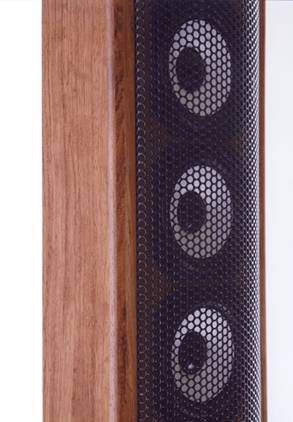 Why is it that this new
term of coherence is not understood? I have suggested a physical reason why
this is so but it does not seem to communicate well. We are all conditioned
when we listen to loudspeakers. We know that these are imperfect devices and
expect to hear less than a live performance. We have learned to ignore the
imperfections — just shove them out of our consciousness and try to enjoy the
music. In fact, we are so conditioned that we need to relearn what to listen
for when it comes to loudspeakers. It is a bad habit and not easily broken. It
takes time to learn what to listen for and then, it is there—perhaps like
riding a bicycle—once learned and never forgotten. It is this that headphones
can reproduce that most speakers cannot—coherence—no woofers, mids and tweeters
and no crossovers—just wide-range drivers like microphones used to make the
recordings. One microphone can cover the entire frequency range. The IDS-25
with all wide-range drivers comes closest to this new experience heard with
headphones but without having the sound inside of your head.
Why is it that this new
term of coherence is not understood? I have suggested a physical reason why
this is so but it does not seem to communicate well. We are all conditioned
when we listen to loudspeakers. We know that these are imperfect devices and
expect to hear less than a live performance. We have learned to ignore the
imperfections — just shove them out of our consciousness and try to enjoy the
music. In fact, we are so conditioned that we need to relearn what to listen
for when it comes to loudspeakers. It is a bad habit and not easily broken. It
takes time to learn what to listen for and then, it is there—perhaps like
riding a bicycle—once learned and never forgotten. It is this that headphones
can reproduce that most speakers cannot—coherence—no woofers, mids and tweeters
and no crossovers—just wide-range drivers like microphones used to make the
recordings. One microphone can cover the entire frequency range. The IDS-25
with all wide-range drivers comes closest to this new experience heard with
headphones but without having the sound inside of your head.
The peaks in drum strikes and other percussion instruments are also an attention getter. Even sounds from violin bowing or music synthesizers are obvious. Perhaps the result of unifying the whole frequency range to wide-range drivers accounts for this dramatic improvement in transient response. This listening quality is clearly audible. The properly combined frequencies produce higher transient peaks instead of hearing interference from different drivers at different locations. As a result, this may be closer to the original waveform. Tone burst tests show excellent reproduction and that may also be related to what I am hearing.
To put it simply, a multi-way system by its nature chops up the signal from the power amplifier into 2 or 3 or more frequency ranges using crossover networks that destroy any coherence in the original signal. Then separate drivers of different construction and in different locations attempt to piece that signal back together like the original signal from the amplifier. A column of full range drivers and no crossovers bypasses this serious loss in coherence and transients. In addition, the low moving mass and smooth response of the drivers can also contribute. It sure makes a difference.
But there seems to be more benefits than just transients. Further listening reveals several other reasons why the system is so fascinating. Voice reproduction sounds extremely natural. I attribute this to the copper insert in the driver magnetic gap that greatly reduces distortion and is particularly noticeable in the voice range. It also greatly reduces the normal impedance rise at the higher frequencies found in ordinary wide-range drivers. In addition, the absence of any crossover networks eliminates several other problems such as impedance mismatch, phase considerations, driver output balance and so on. Smooth response can be obtained throughout the range without the discontinuities between drivers such as woofers, mids and tweeters that have different directional patterns and tonal balance. The small drivers eliminate any hint of a boxy sound found in many speaker systems.
Some systems may have only one driver to handle the whole frequency range and others may have drivers with crossovers to handle part of the frequency range. At high power, these systems could have a new set of problems. The voice coil of the driver has resistance and resistance produces heat. Over a period of time heat can build up and the voice coil and coil form may not be able to dissipate the heat. Higher heat causes resistance of the wire in the voice coil to increase. This is like adding a resistor in series with the speaker system and reduces output but by different amounts depending on frequency. It makes the amplifier appear more like a current source instead of a voltage source. The IDS system has 25 drivers and 25 voice coils. The amount of heat generated per driver is far less over most of the frequency range.
So no single one of these advantages may account for the instant attraction to the sound of the IDS systems but when you put all of the advantages together and play music, it is a new and wonderful experience, never to be forgotten. I have often thought—did I really hear what I thought I heard? So I have to go back the next day and listen again—only to be amazed again.
If you are a classical music lover like me, then you will appreciate good sound. I have been using many Telarc recordings because they appear to be very well recorded. For instance, Pictures at an Exhibition (CD-80296), Bolero (CD-80-171) and Le Sacre du Printemps (CD-80054) are some of my favorites and are good examples of their recordings. When played through the IDS-25 at concert hall levels, the sound is so outstanding; it never fails to bring tears to my eyes. Where have I ever had an experience like this before? When attending concerts at Carnegie Hall in New York City with a seat front and center in the Prime Parquet.
Additional observations
March 2011
I have now spent several years living with the IDS-25. I have not been seriously listening to any other speakers during this time. I recently brought out one of my earlier favorite designs from several years ago, the XR250. I had many good things to say about this speaker. One was the use of the new LD/HP woofers that lowered the distortion by a factor of ten.
Now, on first listening to the XR250, I could not believe what I heard. First, I noticed the imaging was very confusing and I couldn't locate the instruments in Copland's Billy the Kid as well as what I had been accustomed to with the IDS. The sound seemed to come from a wide area and didn't vary as much from instrument to instrument. The sound field had little relative depth and was more like a flat plane between the speakers. The difference was so great I thought perhaps I had wired the 250s out of phase by mistake but a battery test showed they were correct.
The second thing was glaringly obvious having a complete lack of life. There was no punch in the bass drum or other instruments as well. Even the piano seemed lifeless. It was a complete relative loss of transients and peak output. I was so used to the percussive sounds becoming alive that now they seemed dead in comparison. The third thing was the need for a lot more power. I usually set the volume control at 9 o'clock. Now it must be at 12 o'clock for the same listening level. There was no deep bass and the highs seemed to be a little clustered in one frequency area.
All together it was very disappointing for my pet XR250s. I had thought I might live with them for a while but I prefer not to go back now that I know what I am missing in the recordings. The lack of dynamics alone is enough to turn me off. Better dynamics was one of the first things I noticed when first hearing my 4" wide-range single column version but this is much more obvious now with the IDS-25. The sound of the experimental system had kept me pursuing this idea. I suppose it is somewhat from my listening experience over the years and learning what to listen for. Many people are used to inaccurate sound and perhaps have not made many comparisons with live music. They may be happy just enjoying the music with the sound as it is. When an improvement comes along, although it is heard, it may not be recognized right away unless it is pointed out to the listener.
Although the XR250 was unquestionably the best sound at the time, it must be realized that almost thirty years have gone by and improvements in sound are inevitable. A single, wide-range column system was on my mind for many years as the next step for improvements. The result was even better than I had hoped for.
![]()
Learn about the exciting new
stereo loudspeaker system
Questions about the IDS-25 system are answered on my FAQ page.
![]()
